All about scissors: what is it, who invented them and what are they like?

Scissors are an item that is in every home and every office, and often not in a single copy. They are such a natural part of our everyday life that we do not even think about who invented this elementary, but ingenious in its simplicity tool, which is now actively used in various spheres of life: hairdressing, gardening, industrial production, cooking and others. areas. How and when scissors appeared, and what they are, we will tell in this article.

What it is?
Classic scissors are a tool that consists of two blades connected in the center by a screw, its main purpose is to cut. What exactly to cut? Almost anything: paper, fabric, food, metal, depending on the application.
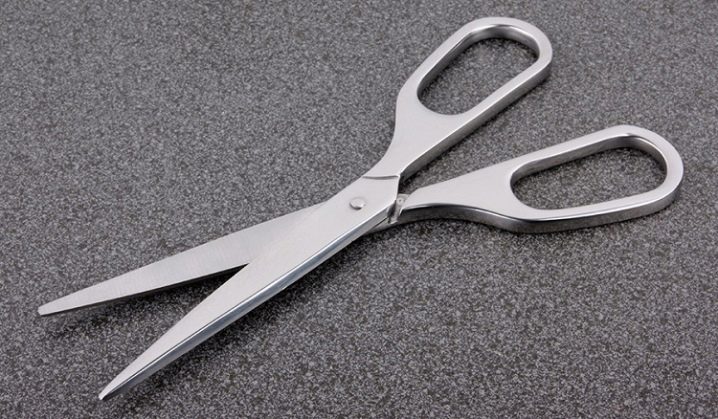
Origin story
The history of scissors began more than four millennia ago: they appeared in the II-I centuries BC. NS. The "appearance" of the very first scissors found on the territory of Ancient Rome was still very far from modern, since they resembled tweezers in shape. The object consisted of 2 blades, which had to be connected by forceful pressing on them. It was intended for shearing sheep.
This design existed for about two millennia, until the lever was invented by Archimedes. This became the starting point for a significant modification of the scissors. It is attributed to Leonardo da Vinci, who gave the cutting tool the shape we are used to by connecting the blades with a nail, and for convenience making the handles in the form of two rings. Although some scholars call the author of modern scissors an unknown craftsman from the Middle East, attributing these transformations to his account.
There is still controversy about the homeland of the scissors. Not everyone agrees with their ancient origins. Some researchers believe they originated in China. Others call Egypt the country of the first scissors - an object resembling wire cutters was discovered there, made from a solid piece of metal.


In the Middle Ages, scissors acquired not only practical but also aesthetic value. The craftsmen competed to find out who would create a more beautiful and original piece. Scissors were made of iron, and their handles were decorated with elements of steel, silver and gilding, covered with engraving and various ornaments. Their bizarre shapes boggled the imagination: the handles were made in the form of plants, outlandish animals and birds. At that time, scissors were truly works of art, although sometimes at the expense of their practical function. Since the XIV century, scissors have been turning into a woman's accessory - they were often given by a man to his lady of the heart, putting them in a beautiful leather case.
In Russia, the most ancient scissors were found during the excavation of the Gnezdovsky burial mounds (Gnezdovo is a village near Smolensk). Their age dates back to the 10th century. Around the same time they appeared in Europe, and it is interesting that each country is a "producer" of its own type of instrument. So, nail clippers were invented in the Middle East, they were made by an artisan for the wife of a very rich sheikh. The invention of garden shears belongs to England, for the first time the French began to use them for culinary purposes, and the Germans created scissors for cutting metal, which were originally used to dismantle machine parts in case of an accident.


Device and characteristics
Let's take a closer look at how exactly scissors function in our time.
Material
The backbone of modern scissors is made of steel.It has all the necessary characteristics for an object whose purpose is to cut: steel products are strong, hard and wear-resistant, capable of withstanding high thermal and mechanical loads. For the production of scissors, high-carbon, chromium-nickel, chromium vanadium compounds are used. The denser the substance the scissors have to work with, the stronger the material for their manufacture. Handle covers are made of plastic, silicone and rubber.


The form
The shape of the scissors is also determined by the specific task that they will perform. Blades can be straight or curved, with sharp or rounded ends, short or long, with a flat or serrated cutting surface, and they can also be equipped with additional cuts and grooves for various purposes. As for the shape of the handle, it is most often either 2 rings or simple straight handles. Power tools have a special design, different from other types. We'll talk about them below.


Dimensions (edit)
Scissors come in different sizes. Probably the smallest representatives of the genus are manicure products, their length is very small - about 10 cm. This is due to the fact that the task of such scissors is to carefully cut the nails, the size of which is also small. The medium-sized scissors (about 50 cm) include kitchen, stationery and tailor scissors. And, finally, the largest dimensions are garden shears and tools that are designed for cutting metal (their length is about 1 meter, they weigh significantly more than the rest).


What types are there?
Depending on the scope and purpose, modern scissors are of the following types.
Household (or household)
These are classic scissors with straight, smooth blades. They are also called universal, since scissors of this design are used for most household needs: cutting paper, thread, fabric, food. Perhaps, only for cutting nails, they are not suitable, although there are people who use them as manicure.
It is better to take household scissors made of stainless steel - their service life is much higher, and their durability is also higher.
On sale there are options not only for right-handers, but also for left-handers.



Hairdressers
These scissors are used to trim hair and facial hair in men. There are four subspecies.
- Straight scissors... They are similar to household ones, they have smooth blades with sharp ends. Their sharpening angle is standard - 50 degrees, the length of the cutting surfaces is different: there are long, medium and short varieties.


- Thinning scissors... They differ from straight ones in that the inner edge of the blades is not even, but serrated. Notches can be present on one cutting surface, or on both at once. Thanks to this feature, thinning scissors are able to give hair shape and volume - they are used for short haircuts and cutting bangs.
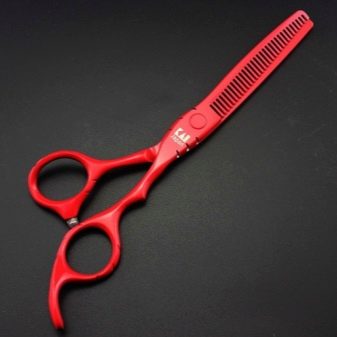
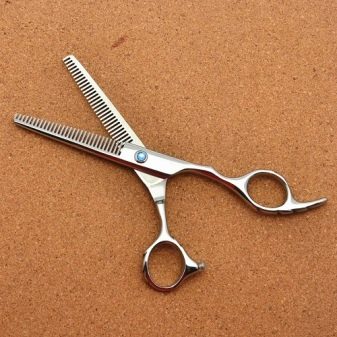
- Checkboxes combine two functions at once: haircut and thinning. One blade is smooth, and the second is fitted with a nozzle with sparse teeth of various shapes.
The ends of the hair cut off with such scissors are of different lengths, due to which they look thicker and more voluminous.


- Hot the scissors look straight outwardly. However, they are electrical and capable of heating to the desired temperature.
When cutting hair with hot scissors, we clog the ends, preventing them from splitting and dry.
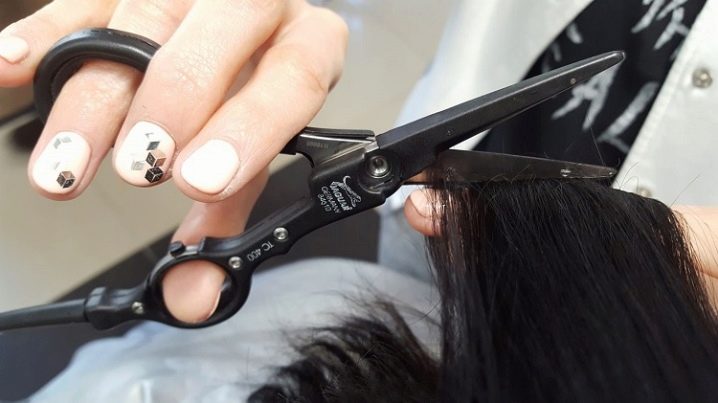
Kitchen
Their purpose is to cut food. In turn, kitchen scissors are divided into universal, multifunctional and specialized. Let's consider each type separately.
- Universal - these are ordinary household scissors, which the hostesses themselves have adapted for culinary purposes.
However, they can no longer be used for other tasks.
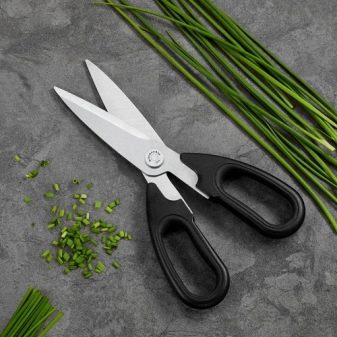
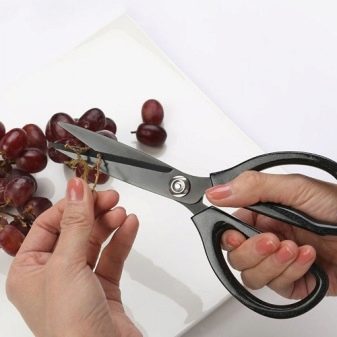
- Multifunctional The scissors are equipped with a wide handle and additional parts that allow, for example, cracking nuts or opening bottles.


- Specialized are designed for one specific purpose. Among them are scissors for butchering meat and fish, made of durable steel. They have slightly curved blades and wide-angle handles and volumetric rings, often equipped with a spring. The design of such scissors allows you to cut meat together with bones. There are also scissors for cutting greenery. They consist of several blades, which make it possible to get many identical pieces of parsley, onion, lettuce or celery with one click on the handle.


Manicure
Such scissors are small in size and thin, pointed at the ends, blades. They are divided into 4 subspecies.
- To trim nails... There are straight and curved options. The first is best used for those with thick nails, and the second is more suitable for shaping thin and brittle plates.


- For trimming the cuticle (transparent skin at the bottom of the nail plate). They have sharper and sharpened blades for delicate skin removal.


- Universal... Able to trim both nails and cuticles.

- Safe. They differ from their "counterparts" with blunt ends, which, on the one hand, make them more suitable for cutting children's nails, and on the other hand, less effective and convenient to work with.


Tailors and tailors
These scissors are used for cutting and sewing, and have a number of specific features.
- One of the rings on the handle is almost 2 times larger than the second. This is done so that you can put 3 or even 4 fingers into a large ring, which is necessary, for example, for working with leather and other dense materials when additional effort is required.
- They are made of more durable steel than household or stationery.
- The angle between the blades and the handle on some models is 90 degrees.
Due to this, the fabric during cutting will not be suspended, but will lie on the table.

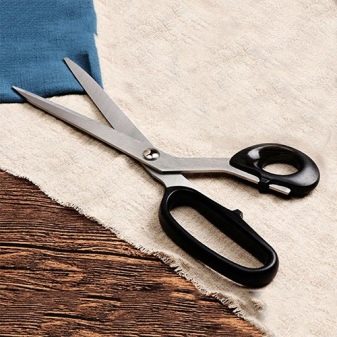
In the arsenal of a professional dressmaker, there are always different types of scissors.
- For cutting the patterns, the same scissors are used as for cutting paper, their length is 25 cm.
- For thread trimming (thread clippers). Their blades are sharpened at the ends and are in the open state, the shape of the tool is similar to tweezers. It is very convenient for them to open the seams. The standard length of the nippers is 10 cm.
- For embroidery, scissors are used, which are called “herons”. Due to the unusual curvature of the handle, they really resemble a heron. With their help, they make appliqués on fabrics and various embroideries.
- Zigzag (jagged edges). These scissors are used to trim the edge of fabric that cannot be hemmed.
- For silk and chiffon, special scissors with a micro-sharpening are used, which prevents the fabric from slipping during the cutting process.
- It is convenient to cut complex patterns with a lot of arched lines with scissors with rounded ends, as well as work with multi-layered fabrics.
- Folding scissors are an indispensable travel companion for a dressmaker.



Stationery (or office)
Cutting paper, including cardboard, is the main task of clerical scissors. They should be made of stainless steel (such specimens are the most durable and durable), however, in offices they prefer to use tools with plastic or silicone handles of different colors and shapes. The reason lies in the greater aesthetics and comfort of such models.
Office scissors must be with rounded ends - this reduces the risk of injury, cutting with them. They can be different in size, the optimal length is 150-220 mm. Keep in mind that longer scissors are better for cutting straight strips, while shorter ones are more convenient for making different shapes.
Therefore, these are often bought for children to create applications in school or kindergarten.

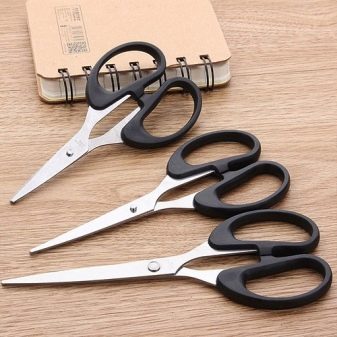
Garden
Such scissors are used in the garden or local area for various types of work.
- Shoot pruning shears secateurs are called. They are able to cope well with branches up to 40 mm in diameter. They have a peculiar shape of cutting blades: curved powerful blades in the open form resemble a bird's beak, and the upper one is larger than the lower one.
This "design" of sharp planes allows you to easily and quickly cut off even the most dense branches.

- For pruning foliage and bushes use scissors with long, straight arms and blades 35 cm long. It is this device that is used to give the bushes the desired shape and create all kinds of interesting green shapes.
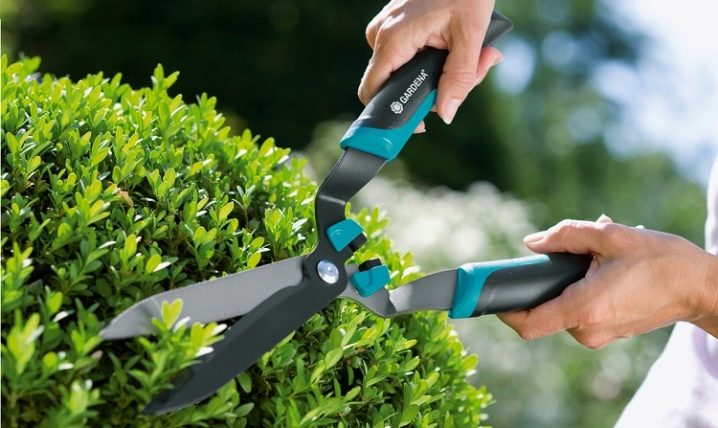
- For cutting grass, especially on a large area, lawn mowers are most often used. However, special garden shears are used to cut vegetation in hard-to-reach areas. They are similar in appearance to the previous type, but the angle between the handles and the working surface of the "hand-held lawnmower" is about 120 degrees. This allows the blade to be in a horizontal position during operation and glide smoothly on the grass.

For metal cutting
This type of scissors is designed for cutting metal leaves of different thickness and density. They are divided into 2 large groups, within which there are numerous subspecies.
Manual
Manual ones are monolithic, that is, they are an integral structure, and composite, the parts of which are bolted together. There are several varieties of these scissors.
- Regular... Cut metal and steel sheets up to 1.5 mm.

- Lever... Metal is cut up to 2.5 mm.

- Roofing. Designed for cutting corrugated board.
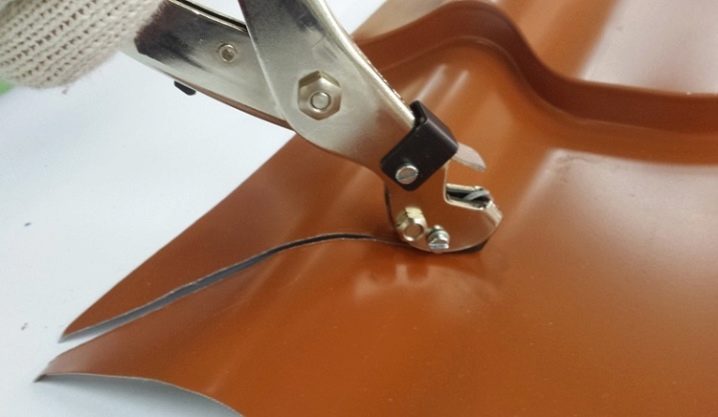
- Hydraulic... There are manual and mechanical. The former are used to cut cables and metal rods up to 25 mm thick, while the latter are used to dismantle large metal structures such as cars or airplanes.


- Dielectric. They are used for cutting electrical wires under voltage up to 1000 V. They have high electrical insulating properties.

- Roller or disc... The metal is cut by rotating the circular knives.


- Pneumatic. They use the energy of compressed air, do an excellent job with curly cutting of metal sheets without deforming them, and also cut roofing materials, rubber and plastic products well.

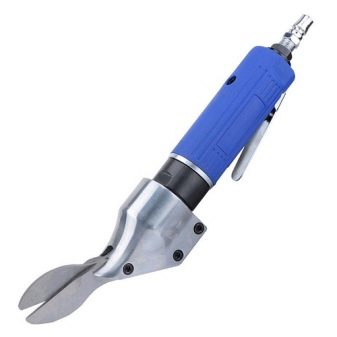
- Self-propelled... This is an invention of Tula masters. They are not self-sufficient tools, but an additional detachable part for a screwdriver or drill. They work with sheets up to 1 mm thick.

Electrical
Electric (electric shears) perform much more work than manual shears, which greatly saves the time of the master and increases his productivity. Such scissors can be recharged from the mains or have a rechargeable battery. They are divided into the following main types.
- Leafy... They are able to cut metal sheets up to 5 mm thick, but work can only be started from the edge of the sheet.

- Slotted... Although the maximum sheet thickness they can handle is only 2mm, the advantage of these scissors is that they have multiple knives, so they can start cutting from any point and work even in the most difficult-to-reach areas.

- Cutting (or die-cut) models. They consist of two basic parts: a matrix and a punch, the principle of which resembles a hole punch. Thanks to this design, they can make cuts of any shape and on any surface - both smooth and wavy.

Press shears (combined)
They are used in industrial enterprises of various sizes - from small to large, for example, machine-building. They process large volumes of metal products efficiently and in a short time. The principle of operation is similar to the guillotine, this explains another name for them - guillotine. Such tools are subject to sheets up to 35 mm thick. Shears are divided into disc, hydraulic and container shears.
An interesting type of press shears are crank (with an inclined knife). Their design makes it possible to make both longitudinal and transverse cuts of a metal sheet up to 8 mm thick, changing the angle of movement of the knife. Alligator scissors are another "heavyweight". They got their name for their external resemblance to a crocodile: their work surfaces resemble the open mouth of an alligator.
Such a tool is intended mainly for cutting scrap metal.

Medical
They are used by surgeons during operations when it is necessary to dissect soft tissue, cartilage or bone. Medical scissors are divided into 3 types:
- articulated - they cut the soft tissues of the human body;
- guillotine - used to work with cartilage and bones;
- microsurgical - designed to perform more "jewelry" incisions.



Each species is subdivided into many more subspecies.
Subtleties of choice
Of course, each type of scissors has its own personal selection criteria. However, there is a list of universal rules that are suitable for almost all types listed in the article. What parameters should you pay attention to when buying scissors?
- First of all they look at materialfrom which they are made. It should be good quality stainless steel. This indicator is especially important for professional tools, for example, tailor's scissors. It is better to give preference to Japanese models: they are made of high quality steel, the production of which has a centuries-old tradition. Take a close look at the tool you want to buy. It should be free of any cuts or damage, especially on the work surface.
- Sharpening and sharpness of blades - the second most important criterion. If the scissors can easily cut through the plastic bag, then they are sharp enough. However, this parameter can always be adjusted by a professional. Just keep in mind that the more carbon is in the scissors, the better they will sharpen.
- Smooth running of the scissors is also of great importance. The cutting planes should open and close not too slowly, but not too quickly - at an average pace. The movement of the blades is uniform, without sudden jolts, jerks and stops. There should be a small gap between the blades when closed - only the tips fit snugly together.
- When you close the scissors, then one the cutting blade must fit exactly onto the other, the edges of the two blades should ideally coincide, only a slight deviation from the norm is permissible.
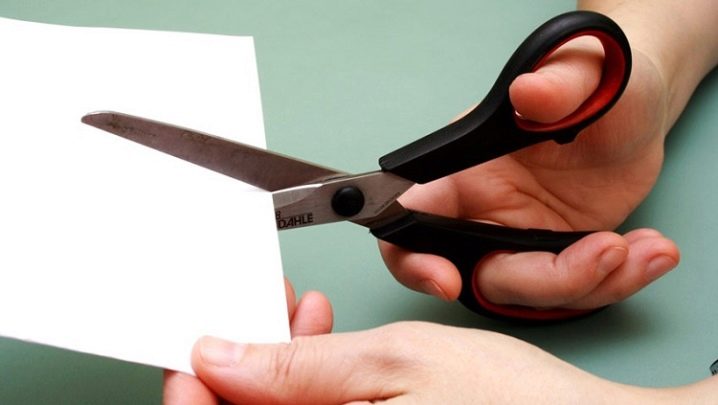
Terms of use
With all the simplicity of the design, scissors are a traumatic tool, and if you handle it carelessly, you can either get yourself hurt or injure a person who is nearby. Therefore, use this tool with extreme caution! Do not take scissors by one blade - you can cut yourself on its sharp edge. You can transfer the tool to another person only with the handles forward, holding onto the closed working surfaces.
Separately, it should be said about the rules for handling metal scissors, especially electric ones. When working with them, you need to be extremely focused on the process, not being distracted by extraneous things. Clothing should not be loose and should not have any parts to catch on. It is also necessary to wear a special headgear and goggles. Do not forget to turn off the appliance after you finish working with the electric scissors. In order for the tool to have a long life, use it only for its intended purpose.
That is, you should not cut paper with nail scissors, and fabric with kitchen scissors.

Care and storage
Let's take a look at a few rules on how to properly store and care for your scissors.
- The scissors should be cleaned periodically.This is especially true for professional tools, for example, manicure or hairdressing salons - particles of nails and hair remain on them. You can wipe them with a wet cloth or wash them with hot water, and then be sure to dry them using a hair dryer. If this is not done, rust will form on the instrument over time.
- Once a month, the middle zone, where the screw is located, and in which the blades are connected, must be lubricated with a special oil. This should be done by spreading the blades and rings to the sides. This procedure is mandatory for hairdressing scissors.
- When the screw is loosened and the blade connection is loosened, it is necessary to tighten it with a screwdriver.
- You need to store the scissors in a closed state with the blades connected, it is advisable to put them in a case.
- Do not let the scissors become dull. To prevent this, or if the blades have already become poorly cut, it is necessary to sharpen them. Try to carry out this procedure regularly, do it yourself at home or in the workshop.
Many centuries have passed since the first scissors appeared. During this time, the world has changed dramatically - today we live in the era of high information technologies. But in the 21st century, scissors have not lost their relevance and, having traveled a long way of development, continue to improve and penetrate into new spheres of human existence.
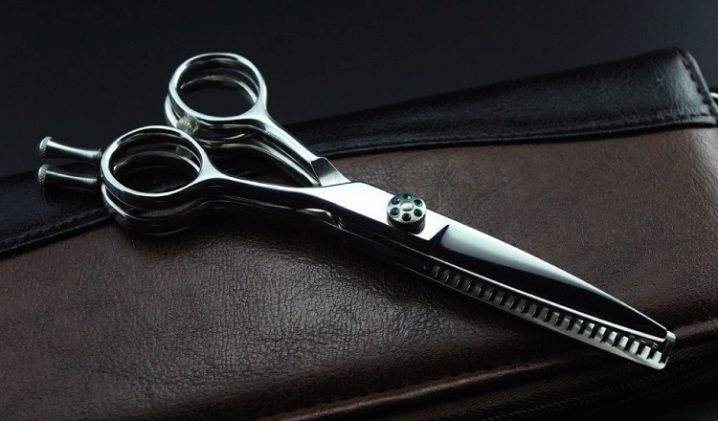
You can learn how to sharpen scissors correctly by watching the video below.













The comment was sent successfully.